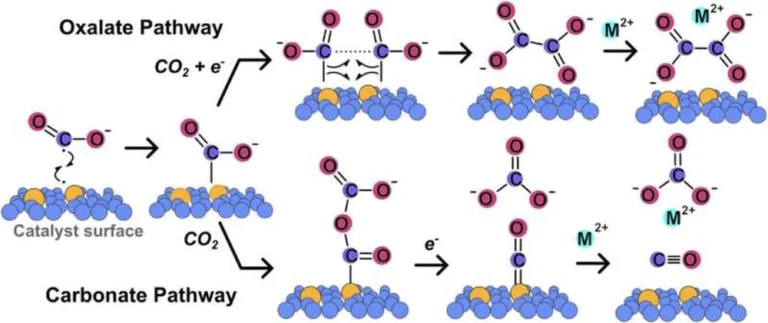
University of Michigan Researchers Convert Captured CO₂ into Cement Materials
Researchers at the University of Michigan developed a method to capture carbon dioxide and convert it into metal oxalates, which are used in cement production. They published their findings in Advanced Energy Materials.
The proposed carbon capture method. Image from University of Michigan.
>> In Other News: Blue Spirit Targets First Flight For Hydrogen Four-Seater Early 2026

The proposed carbon capture method. Image from University of Michigan.
Methodology: Lead catalyst
Previous research has shown that lead can be used as a catalyst to convert carbon dioxide into metal oxalates. However, this method typically requires large amounts of lead, an environmental and human health hazard.
Charles McCrory, associate professor of chemistry and macromolecular science and engineering, and his team at the Center for Closing the Carbon Cycle (4C) found that using polymers to control the microenvironment around the lead catalysts reduced the amount of lead needed to convert carbon dioxide.
The team used a set of electrodes to produce oxalate from carbon dioxide. At one electrode, carbon dioxide is converted to oxalate. The other electrode is a metal that is being oxidized and releasing metal ions, which bind with the oxalate ions and create a metal oxalate solid precipitate.
Once the carbon dioxide is converted into the metal oxalate solid, it won’t be released as carbon dioxide under normal conditions, said McCrory.
Why traditional cement production has a high environmental cost
According to the EPA, 92 cement plants reported emissions of 67 million metric tons of carbon dioxide equivalents in 2019, 10% of the industrial sector’s direct reported emissions.
The most common type of cement is Portland cement. The main ingredients are calcium, silicon, aluminum, and iron. According to McCrory, producing this kind of cement has a high energy cost and a large carbon footprint. This is why he and his colleagues began looking into ways to mine carbon dioxide and convert it into materials that can be used to make cement.
Charles McCrory and the team
"This research shows how we can take carbon dioxide, which everyone knows is a waste product that is of little-to-zero value, and upcycle it into something that’s valuable," said McCrory.
"It’s a true capture process because you’re making a solid from it," he said. "But it’s also a useful capture process because you’re making a useful and valuable material that has downstream applications."
"Metal oxalates represent an underexplored frontier—serving as alternative cementitious materials, synthesis precursors and even carbon dioxide storage solutions," said Jesús Velázquez, a co-lead author of the study and associate professor of chemistry at UCD.
"In this work, we have an example of a trace lead impurity actually being a catalyst. I believe there are many more such examples in practice catalysis, and also that this is an underexplored opportunity for catalyst discovery," said Anastassia Alexandrova, a co-lead author of the study and professor of chemistry and materials science at UCLA.
McCrory says the next steps will be to further study how to scale up the process, particularly the formation of the metal oxalate solid.
About University of Michigan
The University of Michigan is a top-ranked public research university in Ann Arbor, Michigan, known for excellence in education, research, and public service across a wide range of disciplines.
Subscribe to the newsletter
Daily decarbonization data and news delivered to your inbox
Follow the money flow of climate, technology, and energy investments to uncover new opportunities and jobs.
Latest issues
-
Tech Breakthrough Turns Salty Waste into Carbon Gold?
Inside This Issue 💧 Ebb Partners with Saudi Water Authority to Transform Desalination Brine into Megaton-Scale CO₂ Removal 🏭 CO280 Successfully Completes Carbon Capture Field Pilot at a U.S. Pulp ...
-
Air Liquide Just Solved Hydrogen’s Hardest Problem
Inside This Issue ⚗️ Air Liquide's Ammonia Cracker Unlocks Hydrogen Trade 🤝 BASF and ExxonMobil Join Forces to Advance Low - Emission Hydrogen Through Methane Pyrolysis Technology 🔥 Haffner Energy...
-
Texas Bypasses EPA, Unlocks Billion-Dollar CCS Rush
Inside This Issue ⛽ Texas Bypasses EPA, Unlocks Billion-Dollar CCS Rush 🏭 Proposed Blue Ammonia Plant In Ingleside Moves Forward After Heated Debate 💡 Hydrogen Could Be The Secret To Unlimited Ene...
Company Announcements
-
James B. Hartwell Agrees to Join Canadian Biogas Investments Inc. as President and CEO
CALGARY, AB, Nov. 19, 2025 /CNW/ - Canadian Biogas Investments Inc. ("CBI"), a Calgary-based developer of dry fermentation anaerobic digestion projects, is pleased to announce that investment execu...
-
XCF Global Welcomes Growing Momentum for Sustainable Aviation Fuel Adoption in the United States
Policy Momentum: Federal and State Policy Alignment Is Accelerating Nationwide SAF Adoption Policy Momentum: Federal and state policy alignment is accelerating nationwide SAF adoption Market Oppor...
-
YOAKUM COUNTY, TEXAS Return Carbon, a leading project development and investment company in carbon markets, in collaboration with the Permian Energy Development Lab (PEDL), is proud to announce the...
-
BGN Announces Strategic MOU with XCF Global to produce and supply Sustainable Aviation Fuel
BGN and XCF Global Sign MOU to Develop Global Production, Distribution and Logistics Infrastructure for SAF and Other Renewable Fuels BGN joins International Air Transport Association (IATA) as st...